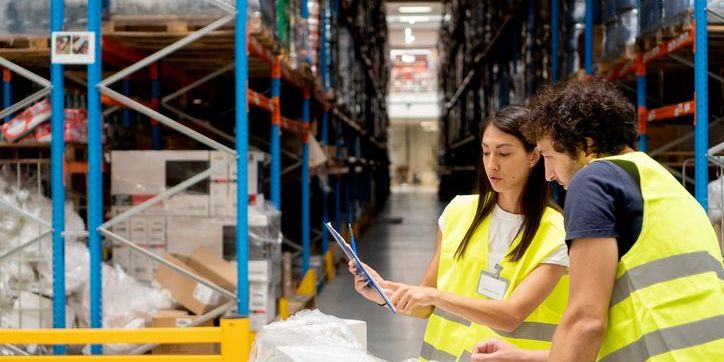What is a Shipping and Receiving Clerk?
A shipping and receiving clerk is a vital role within the logistics and supply chain management of a company. These clerks are responsible for managing incoming and outgoing shipments of goods, ensuring that the correct items are received, stored, and dispatched efficiently. This role involves coordinating with various departments such as purchasing, warehouse, and transportation to ensure smooth operations.
Shipping and receiving clerks manage inventory levels and ensure timely delivery of goods to customers or other departments within the organization. Communication skills are important as clerks often interact with suppliers, carriers, and internal teams to coordinate logistics and resolve any issues that may arise during the shipping process.
What does a Shipping and Receiving Clerk do?

Duties and Responsibilities
The duties and responsibilities of a shipping and receiving clerk typically include:
- Receiving Shipments: This involves physically receiving incoming shipments of goods, verifying the contents against packing slips or purchase orders, and inspecting items for damage or defects.
- Inventory Management: Maintaining accurate inventory records by updating databases or inventory management systems with received shipments, adjusting inventory levels, and monitoring stock levels to ensure adequate supply.
- Packaging and Labeling: Properly packaging items for shipment, including selecting appropriate packaging materials, ensuring items are securely packed to prevent damage during transit, and affixing shipping labels and documentation.
- Shipping Coordination: Coordinating outbound shipments by selecting appropriate shipping methods and carriers, preparing shipping documents such as bills of lading or shipping labels, and arranging pickup or drop-off with carriers.
- Quality Control: Conducting quality inspections of outgoing shipments to ensure that items meet quality standards and are properly packaged for transit.
- Documentation and Record Keeping: Maintaining accurate records of shipments, including documenting serial numbers, lot numbers, and other relevant information, and generating shipping reports as needed.
- Communication: Communicating with internal teams, external suppliers, and carriers to coordinate shipping activities, resolve shipment discrepancies or issues, and provide updates on shipment status.
- Safety and Compliance: Adhering to safety protocols and regulations, including proper handling of hazardous materials, and ensuring compliance with shipping regulations and customs requirements.
- Problem Solving: Identifying and resolving shipping-related issues such as incorrect shipments, damaged goods, or delays in transit, and implementing corrective actions to prevent reoccurrence.
- Warehouse Support: Providing support in the warehouse as needed, including picking and packing orders, conducting inventory counts, and assisting with general warehouse duties to maintain a clean and organized workspace.
Types of Shipping and Receiving Clerks
There are several types of shipping and receiving clerks, each with specific responsibilities tailored to different industries and organizational needs. Some common types include:
- Cold Storage Shipping Clerk: Works in a cold storage facility, handling shipments of temperature-sensitive goods such as perishable foods or pharmaceuticals. They must ensure that proper temperature control measures are maintained throughout the shipping process to preserve product quality.
- Cross-Docking Clerk: Works in a cross-docking facility where incoming shipments are quickly unloaded from inbound trucks and loaded onto outbound trucks with minimal storage time in between. They play a key role in coordinating the flow of goods to maximize efficiency.
- Documentation Clerk: Specializes in managing shipping documentation, including preparing bills of lading, export/import documents, and customs declarations. They ensure that all required paperwork is completed accurately and submitted on time to facilitate smooth shipment transactions.
- International Shipping Clerk: Specializes in coordinating shipments that cross international borders, including managing customs documentation, compliance with import/export regulations, and arranging freight forwarding services.
- Logistics Coordinator: Manages the overall logistics operations, including coordinating inbound and outbound shipments, optimizing transportation routes, and overseeing inventory management to ensure efficient supply chain operations.
- Manufacturing Shipping Clerk: Works within a manufacturing facility to coordinate the shipment of finished goods to customers or distribution centers, ensuring timely delivery and adherence to customer specifications.
- Parcel Clerk: Focuses on processing small parcel shipments, such as those handled by courier services like FedEx or UPS. They may be responsible for labeling packages, sorting shipments, and ensuring timely delivery to customers.
- Retail Shipping and Receiving Clerk: Works in a retail environment, handling both incoming shipments from suppliers and outgoing shipments to customers. They may also assist with stocking shelves and managing inventory levels on the sales floor.
- Warehouse Receiving Clerk: Focuses on receiving incoming shipments, inspecting items for damage, verifying quantities, and updating inventory records.
- Warehouse Shipping Clerk: Primarily responsible for coordinating outbound shipments, preparing shipping documents, and arranging transportation for goods leaving the warehouse or distribution center.
What is the workplace of a Shipping and Receiving Clerk like?
The workplace of a shipping and receiving clerk can vary depending on the type of industry and organization they work for. In general, shipping and receiving clerks are typically based in warehouses, distribution centers, or retail stores where goods are stored, processed, and shipped. These environments can range from large, bustling warehouses with extensive inventory to smaller, more specialized facilities focused on specific types of products.
Within these workplaces, shipping and receiving clerks often spend much of their time on their feet, moving around the facility to receive incoming shipments, prepare outgoing orders, and coordinate with carriers or delivery drivers. They may use equipment such as forklifts, pallet jacks, or hand trucks to move heavy or bulky items, so a basic level of physical fitness and agility is often required for this role.
The work environment can be fast-paced and dynamic, especially during peak seasons or when handling large volumes of shipments. Shipping and receiving clerks may need to multitask and prioritize tasks effectively to meet deadlines and ensure timely delivery of goods. Additionally, these roles require strong attention to detail and organizational skills to maintain accurate inventory records, track shipments, and troubleshoot any issues that arise during the shipping process.
Shipping and Receiving Clerks are also known as:
Shipping Clerk
Receiving Clerk